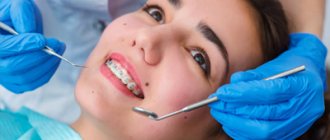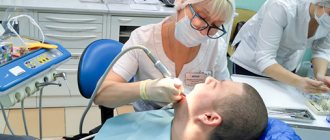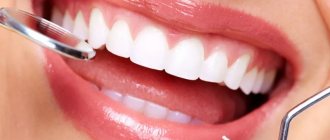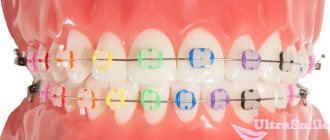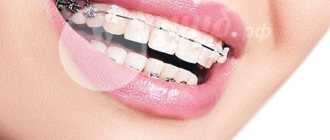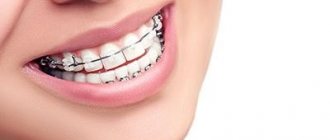Pre-installation inspection | Vestibular and lingual systems | Ligature and self-ligating braces | Advantages of metal devices | Disadvantages of metal braces | Comparison of metal and ceramic models | Popular Ormco braces | Installation | Diet and hygiene | Before and after photos | Reviews
Miniature metal braces made of steel or titanium alloy can withstand high mechanical loads. Durable metal structures correct complex dental pathologies, do not stain, and almost do not rub the mucous membrane. The bracket consists of a body, a base, a groove and wings. In passive self-ligating devices, the lid closes, turns the slot into a tube and holds the archwire. In ligature structures, the arc is fixed in the groove with elastic or wire ligatures. The weak forces of the orthodontic wires move the upper and lower teeth into the correct position. If necessary, the doctor installs elastics, springs and chains into the subligature space of the bracket limited by the wings. Additional elements speed up treatment and set the necessary vectors of orthodontic forces.
The material was verified by Ormco Russia product manager Alisa Sirotko.
non-ligated Damon Q on typodont
Metal braces are small in size compared to ceramic braces. When installing devices made of metal, hygiene is simplified; the material is not subject to corrosion and does not change color. Weak arch forces move teeth sequentially within the jaw bone.
Passive self-ligating metal braces Damon Q2 and Damon Q are made from 17-4 stainless steel. The bracket cover provides low arch friction in the lock and controls tooth rotation. In the grooves of metal non-ligature braces, the arch slides without obstacles, and treatment does not slow down. Metal ligature braces include, for example, Mini Diamond and Orthos. Clinical tests confirm the resistance of steel braces to the forces of arcs, springs and elastic traction.
Daimon Q on the crown of a tooth
Metal braces: pros and cons
Classic metal braces have been used in dentistry for over a hundred years. It is logical to assume that such a significant period indicates many advantages. Let's take a closer look at them.
- Metal braces are reliable and durable, so they are suitable for any clinical cases. They will help correct the most complex malocclusions and crowded teeth.
- The treatment period with metal braces will be shorter than with other systems (this is an important difference between ceramic braces and metal braces). Those patients who want to correct the defect as quickly as possible should choose them.
- Metal braces on teeth are more difficult to damage from hard food, and they are not stained by tea, coffee, wine and carbonated drinks with dyes.
- Finally, this is the most affordable type of orthodontic appliance. Getting metal braces cheaply is not difficult at all.
The disadvantages include the way metal braces look on your teeth. And although manufacturers are constantly improving the appearance of the structure - making smaller clasps and offering self-ligating metal braces without rubber bands or wires, the aesthetics of such systems still leave much to be desired. There is also the possibility of an allergy to the metal of the braces. Despite the use of only safe alloys - titanium, stainless steel, nickel, locks can cause an individual reaction. Before installation, patients prone to allergies must find out what metal the braces of the chosen brand are made of.
FAQ
1. Can there be an allergy to the material of the products? Yes, sometimes there is an allergic reaction to steel structures. In this case, they are replaced with titanium, gold, and platinum.
2. If the lock suddenly comes unglued, how quickly do you need to put it back in place? The sooner the better, since defects negatively affect the effectiveness of the structure (in a few days the tooth can return to its original position).
3. What to do if the structure severely injures the mucous membrane? Orthodontists recommend using a special wax that protects soft tissues from damage.
4. What can cause the arc to break?
From eating hard foods, due to injury, from brushing your teeth too vigorously. Moscow metro station Zvezdnaya, Danube Avenue, 23
Types of metal braces
Based on the place of attachment to the teeth, braces are divided into vestibular and lingual. Another classification is based on the presence or absence of ligatures - auxiliary elements with which the braces are connected to the arch. Ligatures can be in the form of rubber bands or thin wires. There are also mini braces.
- Vestibular structures
are installed on the outer part of the teeth. These are ordinary metal braces that we are all familiar with. Such braces are more universal, correct a defect faster, do not distort diction and require less time to get used to. On the other hand, vestibular systems are visible on the teeth and can damage soft tissue. - Lingual metal braces
are installed on the inside of the teeth, so the brackets are not visible to others. This is an ideal solution for those who want to hide the fact of orthodontic treatment, for example, for public people. True, you will have to prepare for a longer period of bite correction, take longer to get used to the design, and also part with a much more significant amount. - Metal ligature braces
are visually more “heavy” and require frequent (every 3-4 weeks) visits to the orthodontist for correction, since the ligatures quickly stretch. However, some doctors consider such systems more suitable for difficult cases, and the cost of their installation is lower. - Metal non-ligature braces
Instead of ligatures, the systems use special latches or clamps. They do not block the arc, making the friction force minimal, which has a positive effect on comfort and treatment time. Patients with a metal self-ligating brace system can come for corrections half as often, and the procedure itself will last a matter of minutes. However, ligature-free braces are more expensive. - Non-ligature
For more comfortable and aesthetic treatment in orthodontics, special mini-designs have been developed. Their size is 20-30% smaller than standard braces, while the timing and effectiveness of treatment remain the same. This is a more aesthetic alternative to classic metal braces, which also does not require large expenses.
Cost of treatment
The cost of manufacturing and installing metal braces is significantly lower compared to ceramic or sapphire systems, which is one of the most important issues when choosing an orthodontic design. The cost of the simplest braces, including installation, starts from 15-20 thousand rubles. A higher price is possible in the following cases:
- the need for custom manufacturing, as is the case with lingual ones;
- complex metal alloy;
- rare brand and country of manufacture;
- a large number of teeth in need of correction.
In this case, the patient must take into account that additionally regular visits to the orthodontist will be required for correction, and at the final stage, invisible retainers are installed to consolidate the achieved result.
Metal braces from different manufacturers
- Damon Q metal braces
are perhaps the most popular on the market due to their patented design and locking system. The advantages of the Damon brand are reliability and reduced treatment time.
- Victory metal braces
from 3M Unitek are considered one of the most attractive metal solutions. They are distinguished by the anatomical shape of the locks and a special surface that facilitates installation. In addition, 3M metal braces belong to the budget category. - Metal braces “Pilot”
are a domestic development that combines an affordable price and quite a good level of efficiency. There are no innovative technologies here, but the solution copes with its main task. - Metal Marquis braces
from Ortho Technology are also in demand among doctors and patients. They are easy to use and especially hygienic: the clasps are precisely adjusted to the teeth and have a low profile, so they are comfortable to wear, and food residues will practically not get stuck between the elements of the system. At the same time, Marquis metal braces allow you to replace arches in the shortest possible time. - American Orthodontics Empower metal braces
are the flagship products in the orthodontic construction market. They are effective and reliable, as well as aesthetically pleasing due to the small size of the locks. However, the cost of their installation will be higher than many analogues. - Mini Master metal braces
from American Orthodontics are miniature in size (25% smaller than other systems). They are “shrunk” not only in width, but also in thickness, which eliminates injury to soft tissues. Mini Master also gives you the opportunity to wear colored metal braces of your favorite shade.
TOP 10 best systems
- Damon
- Alexander
- In-Ovation
- Insignia
- Empower
- Marquis
- Master and Mini Master
- Sprint
- Orthos
- Victory
Important! If you have possible allergic reactions to metals, the following designs are definitely suitable for you: titanium Orthos, as well as nickel-free Quick and Sprint.
When compiling this rating, we took into account efficiency, price, prevalence in the Russian market, degree of fixation on the teeth (use of a mesh or porous base to use more adhesive glue), and the presence of low-profile and highly polished plates.
Next, we’ll look at why exactly these bracket systems were included in the rating of the best.
Which metal braces are better?
You can choose one or another type of braces only after diagnosis, and also based on the financial capabilities of the patient. A metal ligature braces system would be the best choice if you need to save money, while metal self-ligating braces are suitable for busy people who are short on time. In addition, it is much easier to care for a structure without ligatures.
As for lingual systems, due to their cost and complexity of installation, they are not yet very popular in Russia, and finding a good doctor who specializes in such designs will not be easy. Therefore, based on a combination of factors, vestibular metal self-adjusting braces can be called the optimal solution.
Damon (Ormco company)
Braces are very popular among patients. Often this is not very justified - due to advertising and fees for the brand itself, the cost of such systems is quite high. For the same price you can install more efficient devices. Today in clinics you can find the Q model with a low profile and an innovative latch (the systems work using self-ligating technology), as well as the 3MX (but they are of the old generation). When developing Damon systems, computerized technology is used, which ensures high efficiency of the system. The cost of installation on two jaws at once is from 70,000.
Installation of metal braces
In order to get metal braces, you need to go through three main stages.
- Diagnostic.
This includes: consultation with an orthodontist, medical history, radiography, orthopantomography, photographs of the patient from different angles, drawing up a treatment plan and choosing the appropriate brace system. - Sanitation of the oral cavity.
Treatment of caries and other diseases, elimination of foci of inflammation, if necessary, extraction of teeth or prosthetics, removal of hard deposits and plaque, strengthening of enamel. - Direct installation of a metal bracket system.
The last stage lasts no more than two hours. The doctor prepares the surface of the teeth, glues a separate lock-bracket to each tooth one by one, and fixes the adhesive solution with an ultraviolet lamp. If the locks are installed using the indirect method, that is, all at once, the procedure time is halved. He then connects the clasps to the archwire using ligatures or built-in fasteners. At the end, additional elements are installed - rings, cheek locks, hooks for elastic rods, springs, and so on.
In rare cases, metal braces are placed on one jaw. This is possible with slight curvature of the teeth, which does not affect the bite in any way.
Examination of the patient before installation
An orthodontist installs braces after a comprehensive diagnosis. In the patient’s office, impressions of the patient’s jaws are taken using alginate mass or using digital scanning, and the doctor takes intraoral and portrait photographs. After the examination, the doctor examines models and x-rays and draws up a treatment plan.
The doctor talks about the advantages of metal and aesthetic models in a specific clinical case, after which the patient and doctor make a joint decision. Metal braces correct malocclusions of varying degrees of complexity. The doctor’s skills and cooperation with the patient have a positive effect on the treatment outcome and speed up the path to irresistible smiles.
How is treatment with metal braces performed?
Fixed orthodontic appliances apply constant pressure to the teeth, causing them to gradually move into the desired position. The arch plays a significant role in this process: at first it repeats the irregular shape of the teeth, but tends to return to its original position, thanks to which it smoothly corrects the bite. After each correction, the doctor changes the archwire to a thicker one to increase the pressure.
Let's look at why metal braces straighten teeth faster. The main quality of a metal system is its strength, and it does not really matter what metal is used in the braces. Due to the force of pressure, the teeth move faster and the treatment period is reduced. If the patient is faced with a choice between sapphire or metal braces, he must understand: although the sapphire design looks attractive, it will take a little longer to wear due to the fragility of the material.
So how long do you wear metal braces? Orthodontists call the average treatment period 1.5 - 2 years, but everything, of course, depends on the clinical case. The minimum period is 1 year for mild crowding of teeth, the maximum is about 3 years.
Pilot (manufactured in Russia)
These braces are domestic, but are created in Chinese factories, due to which they have a very affordable price. Many orthodontists do not advise choosing these designs due to the outdated system and the inability to accurately predict treatment results. The cost of installation is from 6 to 10,000 per installation on one row of teeth.
Metal braces are the best option for patients who do not want to spend a lot on treatment and want to see results in the shortest possible time. It is these systems that are the most effective, according to experts, and allow one to cope even with complex pathologies.
Hygiene rules and nutritional features
An integral part of orthodontic treatment with braces is constant monitoring of the condition of the oral cavity. After installing the system, if you experience discomfort or pain from rubbing, you should immediately contact your orthodontist. He will correct the design, apply special food-grade wax to the areas of braces that injure the gums, and prescribe medications for the treatment of inflammatory processes in the oral mucosa.
It is very important to develop good eating habits:
- do not eat solid food;
- healthy vegetables and fruits - only grated or cut into pieces, but in no case whole;
- exclude everything crispy and sticky (crackers, toffee, chewing gum, caramel, etc.);
- avoid sweets and soda to protect tooth enamel;
- Avoid very hot and cold drinks—temperature changes can cause braces to come off your teeth;
Anyone who wears braces is recommended to brush their teeth every time after eating, most thoroughly before going to bed. It is necessary to use tools such as:
- orthodontic brushes (with a small compact head and a V-shaped recess in the middle) for high-quality and gentle cleansing;
- dental floss (preferably orthodontic);
- an irrigator that will help remove food debris, plaque, and also prevent bleeding by massaging the gums;
- brush-brush for cleaning locks and removing stuck food in braces;
- restorative mousses with minerals.
It is recommended to visit a hygienist for professional teeth cleaning approximately once 3 months.
Truth or lie? Popular myths
Patients often believe myths that prevent them from achieving a beautiful and healthy smile. It is important to dispel such false statements:
1. “Metal braces look unsightly.” On the one hand, this statement is true. The metallic color and the bracket system itself attract the attention of others when talking. However, the dentist can offer lingual structures that remain completely invisible.
2. “Braces are only relevant for children.” Such beliefs are associated with the high prevalence of various correction methods among adolescents and schoolchildren. This is explained by the fact that the desire to have a beautiful smile is most in demand at a young age, and the treatment itself occurs faster during the period of active growth and mobility of teeth. However, a person should think about his well-being even after 30 years, because healthy and straight teeth are not only a beautiful smile, but also the condition of the entire body as a whole.
3. “The treatment is painful.” Partially, this is true. The patient may experience some discomfort after a power arch tightening. However, the unpleasant sensations last only 1-2 days, after which the jaw adapts to the new conditions. Pain and itching in the gums go away on their own and, in rare cases, require medication.
4. “Fixed metal structures damage the enamel, which means they negatively affect dental health.” Before attaching the locks to the enamel, the patient undergoes complete treatment of carious changes and extensive diagnostics of the strength of the enamel. Based on the data obtained, the dentist assesses the risks of complications. Healthy enamel can withstand the load of the structure without damage, and maintaining oral hygiene and following the doctor’s recommendations on nutrition eliminate the risk of caries in the areas of the tooth around the clasps.
To summarize, we can conclude that metal braces have many advantages. This is one of the most popular systems for correcting malocclusion. Moreover, their demand in the field of orthodontics is explained not only by their low cost, but also by the short treatment time, as well as the ability to correct complex defects.
What is the difference between ceramic braces and metal braces?
Many patients are interested in what is better - ceramic or metal braces. You need to understand that both types of systems cope well with their task, the only question is in the details.
When choosing ceramic or metal braces, you should decide on your priorities: aesthetics or treatment time? Ceramic systems are practically invisible on the teeth, and this makes the correction psychologically more comfortable. On the other hand, if it takes a year and a half to correct a moderate defect with metal braces, then with ceramic braces it will take about two years.
Lifestyle will help you understand which braces are better - ceramic or metal. Metal is much less capricious: it does not stain under the influence of red wine, tea and coffee, and is also not prone to chips and cracks.
Another popular question is whether it is possible to smoke with metal braces. If we do not take into account the harm from smoking as such, then it is really better for smokers to install a metal system, since ceramics can change color under the influence of resins.
A brief excursion into history
Metal braces can easily be called a classic for correcting malocclusion and correcting defects in the dentition. Metal braces were first proposed by the American orthodontist Edward Engel. At that time, they were made of metal; the design itself was bulky and quite uncomfortable to wear, it rubbed the mucous membranes and caused a lot of problems in daily life. For many decades, orthodontists used such massive structures and could not offer an alternative option to their patients. Modern orthodontics offers a variety of systems that differ significantly in size, and some remain completely invisible, but metal braces have still not lost their popularity and are still superior to other options in terms of strength and effectiveness.
Combined braces: metal and ceramic
To save on installing an aesthetic system, you can choose combined metal and ceramic braces. When a person smiles, the lower teeth are less visible, so to save money it is worth putting metal braces on the lower jaw and ceramic braces on the upper jaw. This is a worthy compromise between the cost of treatment and psychological comfort during it. Similarly, you can combine sapphire with metal.
Lingual orthodontic systems
This type of structure is located on the inside of the tooth, making it completely invisible to others. The second name is invisible. However, this is not the only advantage - lingual braces systems effectively and quickly combat crowding of teeth, not inferior to traditional metal vestibular lingual devices.
The number of manufacturers of lingual appliances is limited, and some even manufacture to individual orders. The adaptation period to such braces is longer, and during treatment the patient’s diction changes due to the location of the brace system on the inside of the teeth.
The cost of such “invisible” braces is very high and not everyone can afford it, so this type of treatment is mainly chosen by public figures and high-ranking officials for whom appearance is important.
Is it possible to get metal braces inexpensively?
Undoubtedly. Installing regular staples is the cheapest. However, the price of metal braces can vary. Designs with ligatures will cost the least - from 25,000 rubles, a metal non-ligature bracket system starts at 35,000 rubles. Of course, we are talking about vestibular structures, since the price list for lingual systems starts from 100,000 rubles. Ceramic braces with a metal groove will be an order of magnitude more expensive than a conventional system. You also need to keep in mind that metal braces for the upper jaw are more expensive than for the lower jaw. Such designs are the most affordable, and this is also the difference between metal and ceramic braces. The table below will help you navigate the cost of metal structures, as well as a call to a clinic where you can install braces in Moscow.
| Bracket systems | Price |
| Vestibular | from 50,000 rubles |
| Lingual | from 100,000 rubles |
| Mini | from 30,000 rubles |
| Ligature | from 25,000 rubles |
| Unligated | from 35,000 rubles |
How much are
Prices for metal braces in St. Petersburg vary widely. The final cost of treatment is determined by the type of bracket system, the amount of work required for installation, subsequent maintenance, and removal. Unplanned expenses may arise if the locks become unstuck or the arc breaks. The table shows the current minimum prices for equipment and services.
| Name | Cost of OT, rub. |
| Ligature system | 17000 |
| Mini | 14000 |
| Lingual braces | 80000 |
| Self-ligating bracket system | 21000 |
| Direct fixation | 3000 |
| Indirect fixation | 6000 |
| Taking an impression | 600 |
| Comprehensive diagnostics | 2500 |
| System activation | 2000 |
| Re-fixing the bracket | 450 |
| Replacing the lock | 1400 |
| Removing the bracket system | 3360 |
The price is for one jaw, without installation.
When should correction begin?
Braces are considered one of the most popular dental structures for correcting malocclusion. Indications for installing braces are determined by the dentist after diagnostics, during which a malocclusion or other problems that require special correction may be detected. The main indications are:
- Different types of malocclusion. Malocclusion is not always pronounced; in many patients it is diagnosed during an examination for another reason and does not cause any concern in everyday life. However, proper correction can improve the appearance of the smile in cases of mild problems, while in cases of significant problems, installing braces is one of the most affordable treatment options.
- Dystopia of teeth. If the position of one or more teeth in the dentition is disturbed, then the braces system will correct this deficiency over time.
- Presence of gaps between teeth. Gaps between teeth are an unpleasant aesthetic defect that can be easily corrected with braces.
- Crowded teeth. If teeth are too close to each other, this makes oral hygiene difficult and contributes to the development of caries.
- Disproportion between the upper and lower jaws. During development, the disorder may occur due to bad habits such as thumb sucking, the child's habit of pulling and gnawing hard objects.
If there are medical indications, the dentist recommends that the patient choose one of the options for modern braces and begin preparing for treatment.
Review of Moscow clinics with prices
Metal braces are considered the cheapest. But this applies only to classical systems - external ones with ligature fastenings. Prices for self-ligating and lingual structures often exceed the cost of ceramic and sapphire models.
| Type of metal braces | Average prices in rubles | Moscow clinics providing the service |
| External ligatures | 15 000-50 000 | “UstaDent”, “Ilatan”, “Moscow Doctor”, “As-Dent”, “European Center of Dentistry”, “Dobromed”, “Darmed Dental”. |
| Self-ligating | 30 000-100 000 | “Rutt”, “Dynasty of Doctors”, “Amirdent”, “Dantist”, “Dantistoff”, “Valident”, “NoraDent”, “Medkvadrat”. |
| Lingual | 120 000-300 000 | “Art Dental Studio”, “StomVill”, “Dent-IST”, “Smile-Estet”, “Dentex”, “Multimed”, “Smile”. |
Metal braces are leaders among permanent orthodontic appliances. Most doctors believe that there is nothing better for bite alignment than traditional external systems with ligatures - although they have significant disadvantages regarding comfort and aesthetics.
If appearance is not critical, it is better to install iron structures: with them the correction will be as effective, fast and cheap as possible.
Are there any contraindications
All restrictions can be divided into absolute and relative. The first assume certain pathological conditions in which installation of the device is impossible. Relative contraindications prohibit the fixation of the device only until they are eliminated. The absolute category includes the following phenomena and states:
- mental disorders,
- the absence of a significant number of teeth, in which it would be more advisable to immediately proceed to prosthetics,
- pathologies of the immune and endocrine systems, including diabetes - orthodontic treatment is associated with the risk of inflammation of the gums, namely the periodontal tissues, and this is dangerous not only due to tooth displacement, but also its complete loss1,
- bone diseases,
- pathologies of the heart and blood vessels,
- diseases of the hematopoietic system,
- tuberculosis,
- oncology,
- HIV, sexually transmitted diseases.
Experts in the field of orthodontics include periodontitis, periodontal disease, cysts, granulomas, and allergies to metals as relative prohibitions - just choose a model made of a different material.
Final table comparison of types of structures
| Type of design | Peculiarities | Price |
| Metal | Easy installation. Minimum cost. High efficiency. Noticeable. | The most affordable. |
| Ceramic | Matched to the color of the teeth. Unnoticeable. Durable. Effective due to good adhesion. | Lower than sapphire, lingual, non-ligated, but higher than metal ones. |
| Sapphire | Transparent. Almost invisible. Do not cause allergies. Durable. Suitable for snow-white teeth. | Higher than metal ones, not much higher than ceramics. |
| Lingual | Completely invisible. Effective treatment. Longer addiction. | Premium class |
| Self-ligating | Comfortable to wear. Do not require frequent visits to the doctor. Aesthetic. Can be made from different materials. Speed up treatment. | Premium class |
How they work and how they work
The braces system is a complex device that allows you to move teeth in different directions , but the principle of its operation and structure are quite simple.
Structure:
- Power arc. It has “shape memory,” i.e., when it is installed in the bracket grooves, it takes on the previous configuration.
Each bracket is responsible for a specific tooth, and the power arc transfers the load to them. - Individual locking device (bracket). It can have a variety of shapes and sizes, but in general its structure is the same.
The bracket structure includes: a support platform with a groove for the arch placed on it, and wings, with the help of which the arch is fixed with a ligature. - Orthodontic rings. There are 2 options for attaching the bracket - gluing with a composite material or welding to a ring placed on the tooth. They are usually placed on the molars, ensuring that the braces adhere tightly to the jaw.
- Elastic or metal ligatures. In the first case they are rubber rings, in the second they are a kind of wire. A detail such as a ligature allows you to reliably fix the arch in braces in the correct position.
- Wings that allow you to attach arches to braces using ligatures.
The effectiveness of the entire structure as a whole depends on each of these elements. When installing the system, the locks are attached to each tooth and then connected with an archwire. It is installed in the groove and secured with a ligature.
Fixed appliances work by applying constant pressure to the teeth. The arch, trying to take its previous shape, puts pressure on certain teeth, thereby correcting the position of the entire dentition. Teeth move rather slowly, which affects the timing of orthodontic treatment.
An arch is made to individual sizes for each person. It is designed to form the correct bite. After installing the locks, it is attached to them and performs its function - it exerts pressure on the jaw, trying to return to its original position.
Rating of popular systems
The choice of metal braces is huge, and choosing a specific system is not easy. The following 12 models are most often installed - they are considered the best in their class.
Damon
Damon System (Damon) - the most popular non-ligature braces. Produced by the American company Ormco. This model is named after its inventor, Dwight Damon.
The Damon brand combines several types of braces: metal, ceramic and combined. Iron ones are available in two variations:
- Damon 3MX. Classic self-ligating designs with standard size plates.
- Damon Q. An improved model, it features small brackets, double grooves for fastening the arc and improved locking fastenings.
Damon braces have good aesthetics for metal systems and excellent positioning: the special base of the plates ensures their tight fit to the enamel. But the main advantage of the models is organic treatment. The design acts on the teeth with low forces: this allows the units to be moved without disturbing the trophism in soft and hard tissues.
Damon System – popular non-ligature systems
Victory
Victory braces from 3M Unitek (USA) are chosen because of their low cost and versatility. These are classic vestibular structures with ligatures. The shade of the rubber bands is selected depending on the patient’s preferences: colorless or colored. Therefore, the model is equally popular among adults and teenagers.
Features of the Victory model:
- low profile of the plates - they are comfortable due to their small size;
- expanded wings on the plates for premolars - this provides better fixation on the 4th and 5th teeth;
- APS system: braces are supplied with pre-applied glue on the brackets, which makes the doctor’s work easier and improves fixation.
Mini Diamond
In the Mini Diamond metal systems, Ormco managed to combine high comfort, durability, treatment efficiency and low price. The model has many advantages:
- plate size reduced by 30%;
- quick adaptation and high comfort due to small brackets with rounded, polished corners;
- reliability – parts are made of medical steel, which is resistant to damage and deformation;
- shortened teeth straightening time – Mini Diamond quickly corrects malocclusions, treatment rarely takes more than 1.5 years;
- precise positioning – ensured by the diamond-shaped brackets;
- excellent fixation: achieved thanks to the mesh base of the Optimesh XRT plates;
- installation of brackets as close as possible to the gums - the base of the plates for premolars is increased, which allows them to be securely fastened even on semi-impacted teeth and on crowns with low height.
Mini Diamond parts are made of medical steel
Mini Diamond uses a ligature fastening type. Therefore, it is suitable for solving any occlusion defects.
In-Ovation
Under the In-Ovation (Innovation) brand, the American company Dentsply GAC produces several types of self-ligating metal braces:
- In-Ovation R – conventional outdoor systems;
- In-Ovation L – lingual constructions;
- Ovation Mini is a version with a reduced bracket size for patients with small crowns;
- No Trace is an internal model for short-term therapy: eliminating minor defects or to consolidate results at the final stages of treatment.
Innovation braces are tightly and reliably fixed thanks to the anatomical shape of the plates and a multi-level mesh base. They are good for solving various problems with occlusion: the system is equipped with hooks that at any time allow you to abandon the self-ligating type of fixation and switch to ligature fastenings.
The braces are securely fixed thanks to the anatomical shape of the plates
Master (Mini Master)
American Orthodontics has developed the universal Master systems. These are classic ligature braces made of medical steel. Available in 3 versions:
- Master – with the usual size of brackets;
- Mini Master – with plates reduced by 17%;
- Mini Master LP – with extremely small braces (25% smaller than regular ones).
Thanks to the variety of sizes, Master braces are able to solve a wide range of problems and are used in patients with various clinical situations: low crowns, impacted teeth, increased crowding, etc.
Master is often chosen due to its comfort. The plates in the system are small, laser polished, with rounded edges. They are easy to care for: the model has a minimum of areas into which food gets clogged. And the body of the brackets has a patented Maximum Retention base, ensuring a perfect fit.
Master - classic ligature braces made of medical steel
Empower
All-metal Empower braces are another development from American Orthodontics. Unlike the Master series, these are self-ligating systems. They are available in 2 types: active or passive. The type of design is chosen by the doctor based on clinical features.
Patients leave reviews of Empower as reliable and comfortable braces. The special shape of the wings of the brackets and the rounded corners of the grooves make wearing the system comfortable. And the mesh base of the Maximum Retention plates and the unique design of the locks improve fixation.
Pilot
Pilot (Pilot) – Russian metal ligature systems. These are the cheapest braces in domestic clinics. Although the designs have not been significantly modified for several years, they are popular due to their high strength and low price.
Pilot – old style braces. They are massive, during the adaptation period they strongly rub the mucous membrane and complicate hygiene. In addition, they do not have innovative improvements that would make the treatment more effective. But the systems cope with the main tasks. In addition, they are made by powder casting, which ensures high strength and minimizes the risk of breakage.
Experience – Japanese-German development
Experience
Experience (Experience) is a Japanese-German development from GC Orthodontics. This is the name of the series under which several models are united:
- Experience metal: systems with standard size brackets;
- Experience mini metal: low-profile designs, characterized by high comfort and improved aesthetics;
- Experience L: lingual braces with small plates.
In Russian dentistry, they often use the classic model – Experience metal.
All Experience models share the following features:
- non-ligature type of fixation;
- low profile - it ensures comfortable wearing and quick adaptation;
- special lock: the latch on the fastenings is made of rhodium alloys - this material is highly durable, reduces friction of the power arc and increases the efficiency of its impact;
- mesh base of the brackets: this surface absorbs more adhesive, which increases the contact area and provides better fixation.
Marquis are characterized by increased strength and low price
Marquis
Marquis (Marquis) - classic ligature metal braces from Ortho Technology (USA). These systems are characterized by increased strength, low price and good comfort. Therefore, they are popular with patients.
Features of Marquis braces:
- low profile;
- rounded edges of brackets;
- reticulate base of plates with hundreds of micropores;
- anatomically accurate shape of the plates;
- increased size of braces for premolars.
Orthos is made from a neutral alloy - titanium
Orthos
Orthos braces from Ormco are preferred by patients with metal allergies. They are made from a neutral alloy – titanium. Thanks to this, we achieved 3 goals:
- reduce the risk of acute reactions to a minimum;
- increase structural strength;
- make plates of small size and thickness.
In addition, Orthos are inexpensive. The price is low due to the use of classic fastenings - ligatures. And the ability to choose the colors of the rubber bands made the systems attractive for adults and children.
Sprint
The Sprint models from the German manufacturer Forestadent are another braces that are recommended for patients with hypersensitivity. They do not contain nickel alloys, one of the most common allergens.
The Sprint series includes 3 models:
- Sprint – systems with standard bracket sizes;
- Mini Sprint – with medium-sized plates and smooth edges;
- Micro Sprint – miniature braces, the smallest in the line.
Under the Sprint brand, the company also produces the Mini Mono series. It also includes 3 models with different bracket sizes: standard, medium and small. The difference between the systems is in the material of manufacture. Mini Mono is made of stainless steel, so they are used only for patients without allergies to metal alloys.
Sprint does not contain nickel alloys - one of the most common allergens
WIN
WIN (Win) is one of the popular lingual braces. Produced by the German company DW Lingual Systems GmbH. They have been used in Russian dentistry since 2013, but have managed to win the love of doctors and patients with their low price, high strength and versatility.
Vin systems are suitable for almost all patients: they are installed for any occlusion pathologies in adults and children. They are also used by allergy sufferers: there are no nickel alloys in the design.
There are no ligatures in WIN: the self-ligating type of fixation facilitates hygiene and speeds up habituation. Individual manufacturing also increases comfort: the plates and arch are cast according to casts of the jaws - they exactly follow the shape of the teeth, which ensures a perfect fit.
